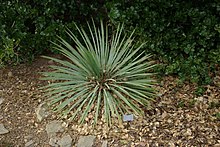Yucca glauca
| Great Plains yucca | |
|---|---|
 |
|
| Scientific classification | |
| Kingdom: | Plantae |
| Clade: | Angiosperms |
| Clade: | Monocots |
| Order: | Asparagales |
| Family: | Asparagaceae |
| Subfamily: | Agavoideae |
| Genus: | Yucca |
| Species: | Y. glauca |
| Binomial name | |
|
Yucca glauca Nutt. |
|
| Synonyms | |
|
|
Yucca glauca (syn. Yucca angustifolia) is a species of perennial evergreen plant, adapted to xeric (dry)growth conditions. It is also known as small soapweed,soapweed yucca, Spanish bayonet, Great Plains yucca and beargrass.
Yucca glauca forms colonies of rosettes. Leaves are long and narrow, up to 60 cm long bur rarely more than 12 mm across. Inflorescence is up to 100 cm tall, sometimes branched sometimes not. Flowers are pendent (drooping, hanging downward), white to very pale green. Fruit is a dry capsule with shiny black seeds.
Yucca glauca is native to central North America: occurring from the Canadian Prairies of Alberta and Saskatchewan in Canada; south through the Great Plains to Texas and New Mexico in the United States.
The "honey ant" (Myrmecocystus mexicanus), among other species, has been observed collecting nectar from Y. glauca.
Soapweed yucca was a traditional Native American medical plant, used by the Blackfoot, Cheyenne, Lakota, and other tribes.
Among the Zuni people, the seed pods are boiled and used for food. Leaves are made into brushes and used for decorating pottery, ceremonial masks, altars and other objects. Leaves are also soaked in water to soften them and made into rope by knotting them together. Dried leaves are split, plaited and made into water-carrying head pads. Leaves are also used for making mats, cincture pads and other articles. The peeled roots are pounded, made into suds and used for washing the head, wool garments and blankets.
...
Wikipedia
